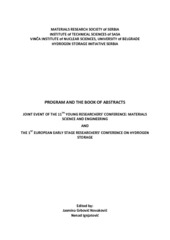| dc.contributor | Grbović-Novaković, Jasmina | |
| dc.contributor | Ignjatović, Nenad L. | |
| dc.creator | Ajduković, Zorica | |
| dc.creator | Ignjatović, Nenad L. | |
| dc.creator | Petrović, N. | |
| dc.creator | Najman, Stevo | |
| dc.creator | Rajković, J. | |
| dc.creator | Kenić Marinković, D. | |
| dc.creator | Krstić, V. | |
| dc.creator | Uskoković, Dragan | |
| dc.date.accessioned | 2018-03-06T09:19:24Z | |
| dc.date.available | 2018-03-06T09:19:24Z | |
| dc.date.issued | 2012 | |
| dc.identifier.isbn | 9788673061221 | |
| dc.identifier.uri | http://dais.sanu.ac.rs/123456789/497 | |
| dc.identifier.uri | https://vinar.vin.bg.ac.rs/handle/123456789/7453 | |
| dc.description.abstract | Huge range of tested biomaterials in recent decades has emerged as an ideal scaffold for cell growth, but few have demonstrated clinical efficacy. Among them, synthetic hydroxyapatite (HAp, Ca10(PO4)6(OH)2) is the most promising because of its biocompatibility, bioactivity, and osteoconductivity. Biocompatibility represents the primary concern for any material to be used as a substitute for natural tissue. Hydroxyapatite particles interact with numerous cellular systems in vivo, and some of these interactions may lead to cell damage and to stimulate platelet activation, coagulation and thrombus formation. The aim of this work was to examine the hemocompatibility of nanocalcium hydroxyapatite substituted with 5% and 12% cobalt (Ca /CoHAp) and hydroxyapatite/polylactidcoglicolid (HAp / PLGA) in relation to pure HAp by testing their hemolytic activities. The results show the discrepancy in hemolytic activity of implanted matherials. The degree of crystallinity of samples had a more dominant influence on hemolysis than the percentage of substituted cobalt. Hemolysis ratios of the nanocalcium hydroxyapatite substituted with cobalt samples were below 3%, indicating good blood compatibility and that they are promising for medical application. | en |
| dc.format | (2012) 49-49 | |
| dc.format | application/pdf | |
| dc.language | en | |
| dc.publisher | Belgrade : Materials Research Society of Serbia; Institute of Technical Sciences of SASA; Vinča Institute of Nuclear Sciences, University of Belgrade | |
| dc.relation | info:eu-repo/grantAgreement/MESTD/Integrated and Interdisciplinary Research (IIR or III)/45004/RS// | |
| dc.rights | openAccess | |
| dc.rights.uri | https://creativecommons.org/licenses/by-nc-nd/4.0/ | |
| dc.source | Joint Event of the 11th Young Researchers’ Conference: Materials Science and Engineering and the 1st European Early Stage Researches’ Conference on Hydrogen Storage: Program and the Book of Abstracts | en |
| dc.subject | biocompatibility | |
| dc.subject | bioactivity | |
| dc.subject | osteoconductivity | |
| dc.subject | nanocomposites | |
| dc.subject | hydroxyapatite | |
| dc.title | Hemolytic activity of bioactive nanocomposites | en |
| dc.type | conferenceObject | |
| dc.rights.license | BY-NC-ND | |
| dcterms.abstract | Рајковић, Ј.; Крстић, В.; Ускоковић, Драган; Кенић Маринковић, Д.; Aјдуковић, Зорица; Игњатовић, Ненад; Петровић, Н.; Најман, Стево; | |
| dc.citation.spage | 49 | |
| dc.citation.epage | 49 | |
| dc.identifier.fulltext | https://vinar.vin.bg.ac.rs//bitstream/id/14054/7447.pdf | |
| dc.identifier.rcub | https://hdl.handle.net/21.15107/rcub_vinar_7453 | |

